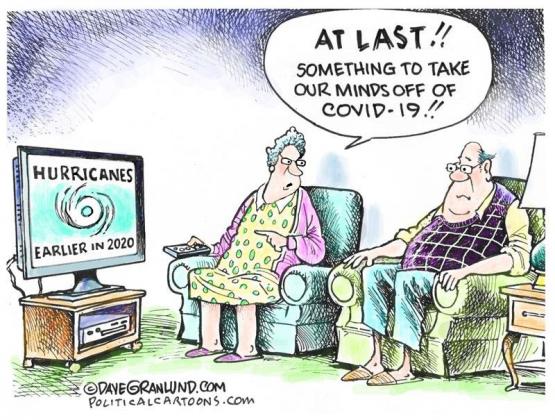
Jim Bradshaw
As the days grow warmer, we begin to watch the weather reports for news of the tropics and the big storms that breed there. Maybe this year we don’t want to look. Practically all of the experts predict that this will be the fifth above-average hurricane season in a row, and some of them say it will be “very active.”
The 65-year norm is 11 tropical storms, six of which become hurricanes, with three of those becoming major storms with winds of 111 miles per hour or more.
Unfortunately, we haven’t seen “normal” seasons in recent years. Far from it.
The 2016 season produced 15 named storms, seven hurricanes and four major hurricanes. In 2017 we saw 17 named storms and 10 hurricanes, six major. That was the costliest season on record, notably because Harvey drowned southeast Texas and part of southwest Louisiana. The 2018 season brought 15 named storms, including Category 5 Michael, which struck the Florida panhandle. 2019 tied as the fourth-most-active season on record, with 18 named storms, including Category 5 Dorian, which devastated the Bahamas.
We could have another year like those, but probably not as bad as 2005, which was by far the most active storm season in modern times. There were 27 named storms that year, 14 of which developed into hurricanes. Seven of those were major storms, including two unforgettable Louisiana storms, Rita and Katrina.
The official NOAA forecast won’t be published until later this week, but it is likely to agree with other generally reliable agencies that say weather patterns this year are likely to be more amenable than usual to storm development, particularly in the late summer.
The Colorado State University meteorology team, which has been issuing increasingly accurate hurricane forecasts since 1984, predicts 16 named storms. Of those, the researchers expect eight to become hurricanes and four to reach major hurricane strength.
CSU says there is a 44% chance that a hurricane of some size will hit somewhere on the Gulf coast. That’s well above the 30% average for the last century.
Lead CSU researcher Phil Klotzbach said in a recent release that “right now every group is calling for an above-normal season. There’s a spread in how [much] above normal, but every group is going above average.”
AccuWeather forecasts 14 to 20 tropical storms, seven to 11 of which will become hurricanes with four to six of them being major storms. Weather Channel analysts expect 16 to 18 named storms, eight or nine of them hurricanes. The European center for long-range weather forecasting does predict a normal season, but it is the only one of more than a dozen agencies to make such an optimistic projection.
We can take some solace in the fact that early season estimates are often unreliable. There is a chance that all of them are wrong, or that weather patterns will change and the predictions will also change. That’s why most organizations give updated forecasts near the start of the season on June 1 and again during the season’s peak, August through October.
But there’s more confidence than usual in this year’s forecasts because of the way the weather patterns compare with other active years, according to Klotzbach. “I would say the confidence is higher than normal,” he said.
We can pray that the predictions do turn out to be too high, but we also might want to pray that if we must have an active season, it will be more like 2010 than 2005. A dozen storms developed into hurricanes in 2010, but not one of them struck the United States.
A collection of Jim Bradshaw’s columns, Cajuns and Other Characters, is now available from Pelican Publishing. You can contact him at jimbradshaw4321@gmail.com or P.O. Box 1121, Washington LA 70589.
